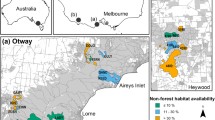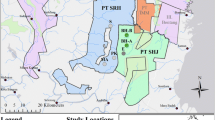Abstract
Gray foxes are successful habitat generalists within the temperate zone of their geographic range, exploiting a wide variety of habitats, including human-dominated landscapes. However, little is known of their use of tropical habitats or their ability to exploit landscapes with human activity. Here, we report the first study to explore the ecology and behavior of gray foxes within the tropics. Extensive camera-trap data (23,598 trap nights) across two different landscapes in Belize, combined with telemetry data on three collared individuals, showed a preference for more open and drier habitats over tropical moist broadleaf forest which is the dominant habitat type in the region. Although foxes did not use the interior of the broadleaf forests, they were detected at the edges and readily exploited areas that had been converted to support human activities (e.g., tourist centers). Home ranges of collared individuals were relatively large (3–7 km2) compared to those of temperate gray foxes, suggesting that they occupy a less productive landscape than those studied further north. This study found that although tropical gray foxes readily exploited human-altered landscapes, just as they do in the temperate zone, they are not the habitat generalists as previously thought and seem unable to fully exploit tropical moist broadleaf forest, the regions’ most dominant and productive habitat type.








Similar content being viewed by others
References
Aebischer NJ, Robertson PA, Kenward RE (1993) Compositional analysis of habitat use from animal radio-tracking data. Ecology 74:1313–1325
Athreya V, Odden M, Linnell JDC, Krishnaswamy J, Karanth U (2013) Big cats in our backyards: persistence of large carnivores in a human dominated landscape in India. PLoS One. https://doi.org/10.1371/journal.pone.0057872
Beyer HL (2012) Geospatial modelling environment (version 0.7.2.1). (software). URL: http://www.spatialecology.com/gme/gmedownload.htm
Calenge C (2006) The package “adehabitat” for the R software: a tool for the analysis of space and habitat use by animals. Ecol Model 197:516–519
Chamberlain MJ, Leopold BD (2000) Spatial use patterns, seasonal habitat selection, and interactions among adult gray foxes in Mississippi. J Wildl Manag 64:741–751
Chapron G, Kaczensky P, Linnell JDC, von Arx M, Huber D, Andrén H, Vicente López-Bao J, Adamec M, Álvares F, Anders O, Balčiauskas L, Balys V, Bedő P, Bego F, Blanco JC, Breitenmoser U, Brøseth H, Bufka L, Bunikyte R, Ciucci P, Dutsov A, Engleder T, Fuxjäger C, Groff C, Holmala K, Hoxha B, Iliopoulos Y, Ionescu O, Jeremić J, Jerina K, Kluth G, Knauer F, Kojola I, Kos I, Krofel M, Kubala J, Kunovac S, Kusak J, Kutal M, Liberg O, Majić A, Männil P, Manz R, Marboutin E, Marucco F, Melovski D, Mersini K, Mertzanis Y, Mysłajek RW, Nowak S, Odden J, Ozolins J, Palomero G, Paunović M, Persson J, Potočnik H, Quenette PY, Rauer G, Reinhardt I, Rigg R, Ryser A, Salvatori V, Skrbinšek T, Stojanov A, Swenson JE, Szemethy L, Trajçe A, Tsingarska-Sedefcheva E, Váňa M, Veeroja R, Wabakken P, Wölfl M, Wölfl S, Zimmermann F, Zlatanova D, Boitani L (2014) Recovery of large carnivores in Europe’s modern human-dominated landscapes. Science 346:1517–1519
Daily GC, Ceballos G, Pacheco J, Suzán G, Sánchez-Azofeifa A (2003) Countryside biogeography of neotropical mammals: conservation opportunities in agricultural landscapes of Costa Rica. Conserv Biol 17:1814–1826
Davis ML, Kelly MJ, Stauffer DF (2010) Carnivore co-existence and habitat use in the mountain pine ridge forest reserve, Belize. Anim Conserv 14:56–65. https://doi.org/10.1111/j.1469-1795.2010.00389.x
Deuel NR, Conner LM, Miller KV, Chamberlain MJ, Cherry MJ, Tannenbaum LV (2017a) Habitat selection and diurnal refugia of gray foxes in southwestern Georgia, USA. PLoS One. https://doi.org/10.1371/journal.pone.0186402
Deuel NR, Conner LM, Miller KV, Chamberlain MJ, Cherry MJ, Tannenbaum LV (2017b) Gray fox home range, spatial overlap, mated pair interactions and extra-territorial forays in southwestern Georgia, USA. Wildl Biol 2017:wlb.00326. https://doi.org/10.2981/wlb.00326
Farias V, Fuller TK, Wayne RK, Sauvajot RM (2005) Survival and cause-specific mortality of gray foxes (Urocyon cinereoargenteus) in southern California. J Zool 266:249–254
Fedriani JM, Fuller TK, Sauvajot RM, York EC (2000) Competition and intraguild predation among three sympatric carnivores. Oecologia 125:258–270
Fieberg J, Kochanny CO (2005) Quantification of home range overlap: the importance of the utilization distribution. J Wildl Manag 69:1346–1359
Figueroa OA (2013) The ecology and conservation of jaguars (Panthera onca) in Central Belize: conservation status, diet, movement patterns and habitat use. PhD. Thesis, University of Florida. Available: http://ufdc.ufl.edu/UFE0045191/00001
Foster RJ, Harmsen BJ, Valdes B, Pomilla C, Doncaster CP (2010) Food habits of sympatric jaguars and pumas across a gradient of human disturbance. J Zool 280:309–318
Fuller T (1978) Variable home range sizes of female gray foxes. J Mammal 59:446–449
Fuller TK, Cypher BL (2004) Gray fox Urocyon cinereoargenteus. In: Sillero-Zubiri C, Hoffman M, Macdonald DW (eds) Canids: foxes, wolves, jackals, and dogs. Status survey and conservation action plan. IUCN Publications, Cambridge, pp 92–97
Gallina S, López-Colunga P, Valdespino C, Farías V (2016) Abundancia relativa de la zorra gris Urocyon cinereoargenteus (Carnívora: Canidae) en la zona centro de Veracruz, México. Rev Biol Trop 64:221–233
Gutierrez SM, Harmsen BJ, Doncaster CP, Kay E, Foster RJ (2017) Ranging behavior and habitat selection of pacas (Cuniculus paca) in central Belize. J Mammal 98:542–550
Harmsen BJ, Foster RJ, Gutierrez-González CE, Silver SC, Ostro LET, Kelly MJ, Sanchez E, Kay E, Quigley H (2017) Long term monitoring of jaguars in the Cockscomb Basin Wildlife Sanctuary, Belize; implications for camera trap studies of carnivores. PLoS One. https://doi.org/10.1371/journal.pone.0179505
Haroldson KJ, Fritzell EK (1984) Home ranges, activity, and habitat use by gray foxes in an oak-hickory forest. J Wildl Manag 48:222–227
Harrison RL (1997) A comparison of gray fox ecology between residential and undeveloped rural landscapes. J Wildl Manag 61:112–122
Hunter L (2011) Carnivores of the world. Princeton University Press, New Jersey
Johnson D (1980) The comparison of usage and availability measurements for evaluating resource preference. Ecology 61:65–71
Kapfer JM, Kirk RW (2012) Observations of gray foxes (Ucocyon cinereoargenteus) in a suburban landscape in the Piedmont of North Carolina. Southeast Nat 11:507–516
Kark S, Iwaniuk A, Schalimtzek A, Banker E (2006) Living in the city: can anyone become an ‘urban exploiter'? J Biography. https://doi.org/10.1111/j.1365-2699.2006.01638.x
Lombardi JV, Comer CE, Scognamillo DG, Conway WC (2017) Coyote, fox, and bobcat response to anthropogenic and natural landscape features in a small urban area. Urban Ecosystems 20:1239–1248
Lopes MG, May J Jr, Foster RJ, Harmsen BJ, Sanchez E, Martins TF, Quigley H, Marcili A, Labruna MB (2016) Ticks and rickettsiae from wildlife in Belize, Central America. Parasit Vectors 9. https://doi.org/10.1186/s13071-016-1348-1
McKinney ML, Lockwood JL (1999) Biotic homogenization: a few winners replacing many losers in the next mass extinction. Trends Ecol Evol 14:450–453
McNab BK (2010) Geographical and temporal correlations of mammalian size reconsidered: a resource rule. Oecologia 164:13–23
Meerman J (2011) Provisional report on the Belize 2011 wildfires: aftermath of hurricane Richard. p 11. http://biological-diversity.info/Downloads/2011_Wildfire_Report.pdf
Meerman J, Clabaugh J (2017) Biodiversity and environmental resource data system of Belize. Online http://www.biodiversity.bz
Meredith M, Ridout M (2018) Overlap: estimates of coefficient of overlapping for animal activity patterns. R package version 0.3.0. https://cran.r-project.org/web/packages/overlap/vignettes/overlap.pdf
Nogeire TM, Davis FW, Duggan JM, Crooks KR, Boydston EE (2013) Carnivore use of avocado orchards across an agricultural wildland gradient. PLoS One 8:1–6
O’ Connell MA (1989) Population dynamics of neotropical small mammals in seasonal habitats. J Mammal 70:532–548
R Core Team (2016) R: A language and environment for statistical computing. R Foundation for Statistical Computing, Vienna, Austria, ISBN 3–900051–07-0, URL http://www.R-project.org/
Reid FA (1997) A field guide to the mammals of central and Southeast Mexico. Oxford University Press, New York
Ridout M, Linkie M (2009) Estimating overlap of daily activity patterns from camera trap data. J Agric Biol Environ Stat 14:322–337
Riley SPD (2006) Spatial ecology of bobcats and gray foxes in urban and rural zones of a national park. J Wildl Manag 70:1425–1435
Ritchie EG, Johnson CN (2009) Predator interactions, mesopredator release and biodiversity conservation. Ecol Lett. https://doi.org/10.1111/j.1461-0248.2009.01347.x
Rountree GH (2004) Comparative study of the home range and habitat usage of red foxes and gray foxes in an urban setting: a preliminary report. In: WW Shaw, LK Harris, and L Vandruff (eds) Proceedings 4th International Urban Wildlife Symposium. University of Arizona, USA, pp 238–244
Schiaffini MI (2016) A test of the Resource’s and Bergmann’s rules in a widely distributed small carnivore from southern South America, Conepatus chinga (Molina, 1782) (Carnivora: Mephitidae). Mamm Biol 81:73–81
Temple DL, Chamberlain MJ, Conner LM (2010) Spatial ecology, survival and cause specific mortality of gray foxes (Urocyon cinereoargentueus) in longleaf pine ecosystem. Am Midl Nat 163:413–422
Wang Y, Allen ML, Wilmers CC (2015) Mesopredator spatial and temporal responses to large predators and human development in the Santa Cruz Mountains of California. Biol Conserv 190:23–33
Acknowledgments
We thank M. Brakeman and the many students and volunteers who assisted with data collection. This work is dedicated posthumously to our friend A. Ramos, whose field craft made the project possible. We gratefully acknowledge his vital contributions to the project and the countless hours of fieldwork he devoted to its completion. We thank the editors, Jason Lombardi and one anonymous reviewer for their valuable input, which improved the manuscript substantially.
Funding
This research was funded by the UK Darwin Initiative 17-012 and Panthera.
Author information
Authors and Affiliations
Corresponding author
Additional information
Communicated by: Karol Zub
Publisher’s Note
Springer Nature remains neutral with regard to jurisdictional claims in published maps and institutional affiliations.
Rights and permissions
About this article
Cite this article
Harmsen, B.J., Sanchez, E., Figueroa, O.A. et al. Ecology of a versatile canid in the Neotropics: gray foxes (Urocyon cinereoargenteus) in Belize, Central America. Mamm Res 64, 319–332 (2019). https://doi.org/10.1007/s13364-018-00413-2
Received:
Accepted:
Published:
Issue Date:
DOI: https://doi.org/10.1007/s13364-018-00413-2




